The 20,000-Year-Old Story of the Golden-Crowned Kinglet
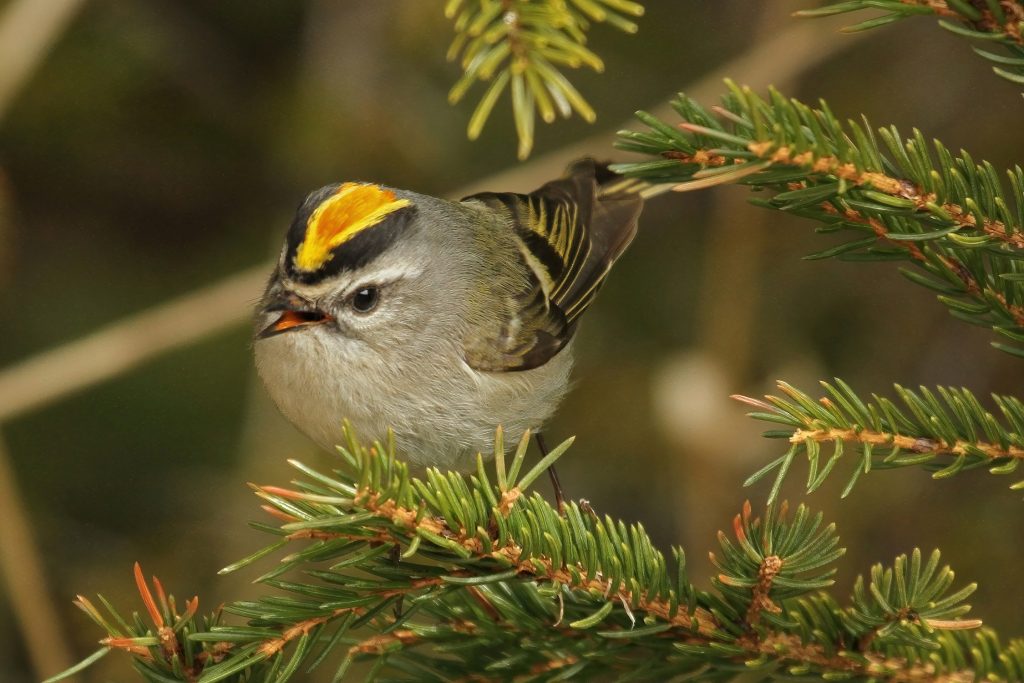
BY DANIKA SCHRAMM
For many people, the topic of genetics has to do with the determination of personal traits like eye colour and inherited disorders such as Huntington’s disease. But for conservation biologists, it is the genetic composition of entire species that is usually of interest. For example, let’s say we are developing a recovery plan for a specific species of duck. Should we apply the same recovery measures to all ducks? Or do some populations need to be handled differently because they are genetically isolated from the rest?
The level of interbreeding among populations is important because isolated populations may, over time, develop genetic adaptations that are specific to their local environment. These unique local gene pools often warrant protection in their own right. Moreover, isolated populations face higher risk of population decline because there is less chance of rescue from individuals flowing in from other populations.
Population genetics is also central to differentiating related species and understanding the process by which species arise in the first place.1 In most cases, speciation occurs when a physical barrier, such as a mountain range or desert, slows or prevents interbreeding between populations. Random genetic mutations will accumulate in the separate populations, and given enough time (think thousands of years), the populations can diverge into two distinct species. Differences in habitat and other environmental factors between the two locations will speed the process of divergence. It is worth noting that, in the modern world, habitat fragmentation caused by humans is also causing populations to become isolated.
Glaciers as Drivers of Speciation
An event that had an enormous impact on Canadian species was the last Ice Age. The glaciers reached their maximum size approximately 20,000 years ago, during the late Pleistocene. At that time, most of what we consider to be our home in Canada was under several kilometres of ice. To survive, Canadian species had to move to pockets of suitable habitat south of the ice sheets, called glacial refugia. In some species, all individuals lived together in a single glacial refugium. In other species, there were multiple refugia that supported separate populations. The genetic outcomes of these two situations were drastically different.
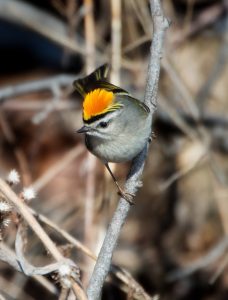
Male golden-crowned kinglets have a bold yellow-and-orange crown and the feathers may be raised in display. Steven Kersting
For species that resided in a single glacial refugium during the Pleistocene, the impacts of glaciation would have been fairly similar for all individuals. Also, interbreeding would have ensured that populations remain genetically similar despite random genetic mutations. In contrast, species that became divided among multiple glacial refugia often developed distinct genetic differences between groups.2
To illustrate how scientists have arrived at these conclusions, I’m going to walk through a real-world example from my own research. One of my study species was the golden-crowned kinglet. These tiny birds are one of North America’s smallest passerines (perching birds in the order Passeriformes), weighing under six grams. They primarily inhabit conifer forests and are known for their characteristic “golden” crowns.
To research the genetics of a species, it is necessary to collect genetic samples from numerous individuals. Furthermore, these samples need to come from multiple locations in order to assess differences among populations. In birds, blood or tissue samples are typically best for genetic research. Tissue samples are often shared through museums and their collections. Blood samples, on the other hand, need to be collected from live birds. As humorous as it would be, we do not chase birds around with butterfly nets hoping to snatch one out of the air. While we do use nets, the process is a little different.
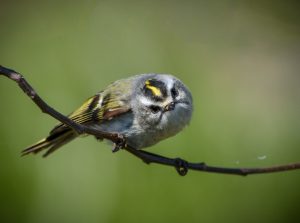
The crown of female golden-crowned kinglets is more subdued than in males and lacks the orange band in the centre. Jen Goellnitz
Most passerines and small-to-medium land birds are caught using mist nets. Mist nets are made of a fine mesh that birds cannot see; they get tangled up in the net as they fly through the underbrush. When a bird is caught we gently untangle it and place it in a soft cloth bag to be weighed, banded, and measured. We take a small blood sample from a vein under the bird’s wing and then allow the puncture to clot while we take the remainder of their measurements (things like wing length, bill length, age, and sex). As soon as the bird’s measurements are recorded, we release it on site. The entire process is brief; birds are usually handled for five minutes or less. Our priority is always bird health and safety. If at any time we feel a bird is potentially experiencing high levels of stress, we release it even if all measurements have not been collected. All birds are captured and handled by trained individuals under appropriate permits.
Once we have collected the required samples, we return to the laboratory to isolate the DNA, which is then sent to a sequencing company. With recent advances in sequencing, hundreds of individuals can be sequenced at once in a short period. The sequence files can be incredibly large and therefore serious computing power is required to analyze them. The first step is to clean and sort the data, after which several different analyses can be performed.
A common approach for visualizing genetic patterns within populations is a statistical technique called Principal Coordinates Analysis. I used this method, among others, to illustrate the similarities and differences in genetic makeup of the golden-crowned kinglets I sampled. The results are presented in the accompanying graph. Each point represents an individual kinglet. Individuals that are close together are more similar in genetic makeup than those that are farther apart. It is easy to see that the kinglets I sampled fall into two distinct genetic clusters: one containing individuals from eastern North America, and one containing individuals from western North America.
The distinct east-west split evident in my kinglet data has been observed in multiple other species. It is believed this pattern is the result of thousands of years of isolation between the two groups during the Pleistocene Epoch, while the two groups resided in separate glacial refugia. Though the two groups are now again able to interbreed in some areas, there has not been enough genetic mixing to counteract the genetic divergence that occurred through the long period of isolation.
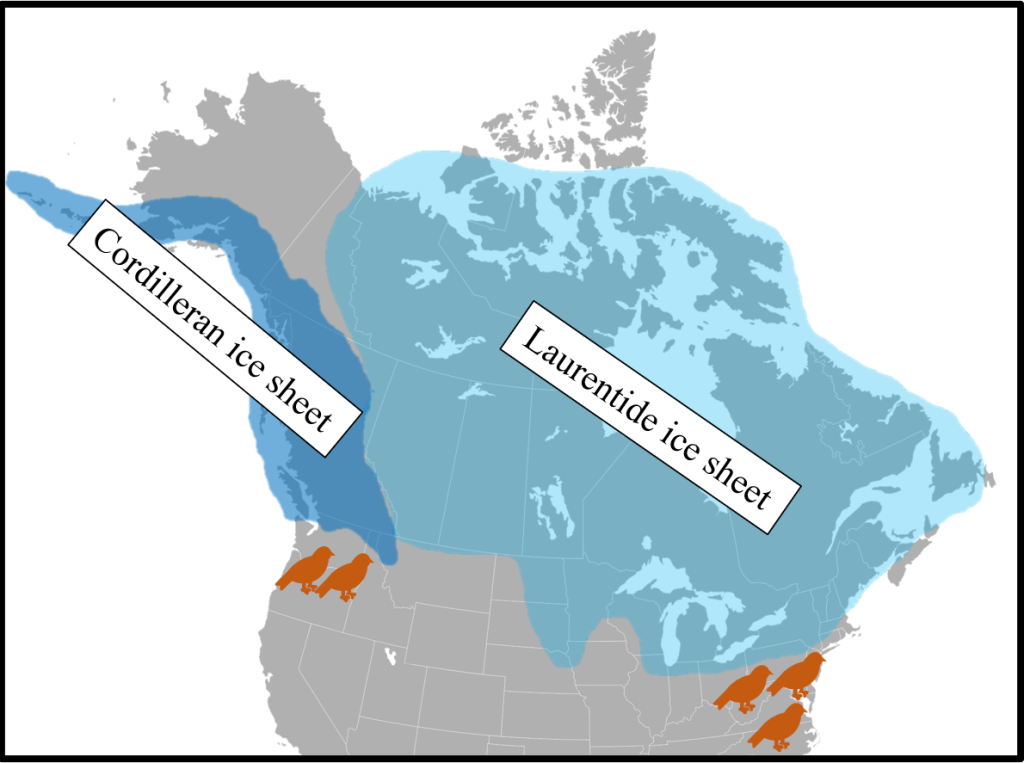
The seasonal range of North American golden-crowned kinglets showing the sample sites used in my study. Map from BirdLife International
Previous research has determined the approximate locations of glacial refugia for many forest-dependent species. Through this research, we know there was at least one pocket of forest near the east coast and another near the west. This lends support to my finding that golden-crowned kinglets were spatially separated during the most recent glaciation. Once the ice began to melt, these tiny birds began to recolonize the new forest as it grew where the ice previously covered the ground.3
Conservation Applications
As more and more information about the genetic structure of species is revealed through research, it is beginning to inform species recovery efforts. However, there are many complexities to grapple with. For example, not all birds exhibit the simple east-west split observed in my golden-crowned kinglet study. Some species have multiple genetic groups whereas others appear to entirely lack significant regional differences. A species’ life history traits, dispersal capabilities, historical and present range, and many other factors all contribute to the patterns we see.
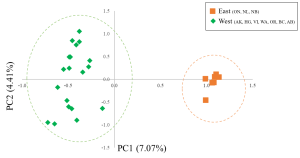
A Principal Coordinate Analysis using genetic data from the birds in my study. Each point represents one golden-crowned kinglet. The farther apart two points are, the more genetic difference there is between them.
There is also the issue of how much genetic variation needs to present for a group to be split into subgroups. You may be surprised to learn that there are no firm rules with respect to delineating subspecies and regionally distinct groups on the basis of genetic structure. This remains a widely debated topic. When it comes to listing species at risk in Canada, the decisions are made on a case-by-case basis by the Committee on the Status of Endangered Wildlife in Canada.
While my kinglet study is just one example of how genetic patterns can be visualized in a population, it is important to remember that this is just the tip of the iceberg of what can be done with genetic data. The conservation implications also should not be ignored, particularly in species at risk or those sensitive to disturbance. And even if the species is not of current conservation concern, the changing climate and landscape can cause unpredictable changes to populations.
I hope that this gentle introduction to population genetics has allowed a peek into some of the research being done today. It is so easy to become bogged down in the complex details when the story itself is often much simpler. Don’t get me wrong, the details and the intricate processes can be fascinating, but the big picture and influence of population genetics is one that will shape research for years to come.
References:
- Toews, D.P.L. et al. (2015). Genomic approaches to understanding population divergence and speciation in birds. The Auk, 133(1), 13–30.
- Weir, J. T., an d D. Schulter (2004). Ice sheets promote speciation in boreal birds. Proceedings of the Royal Society B, Biological Sciences, 271(1551), 1875-1880.
- Burg, T., S. Taylor, K. Lemmen, T. Gaston and V. Friesen (2014). Postglacial population genetic differentiation potentially facilitated by a flexible migratory strategy in golden-crowned kinglets (Regulus satrapa). Canadian Journal of Zoology, 92(2), 163-172.
- Birdlife International and Handbook of the Birds of the World (2016). Bird distribution maps of the world. Version 6.0. Available online at: https://datazone.birdlife.org/species/requestdis.
Danika Schramm recently completed her master’s degree in biology at the University of Lethbridge studying the genetics of two North American passerines. She is an experienced bird bander who has spent time bird banding in both Belize and western Canada.
This article originally ran in Nature Alberta Magazine - Spring 2023.
